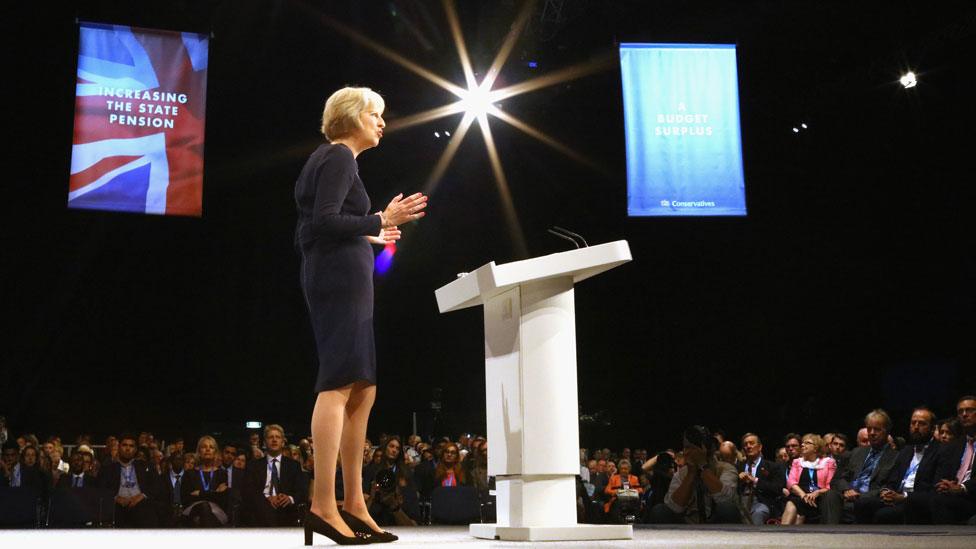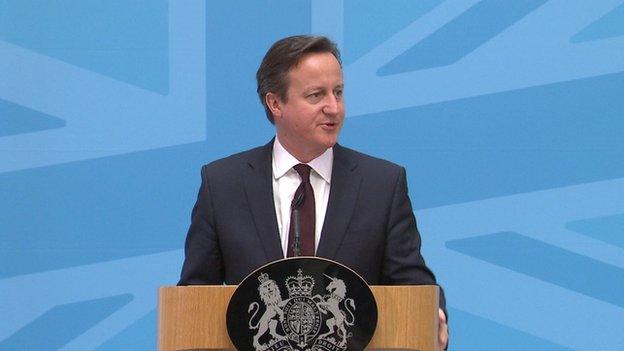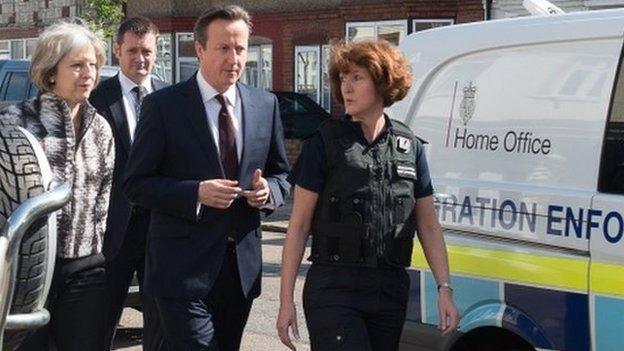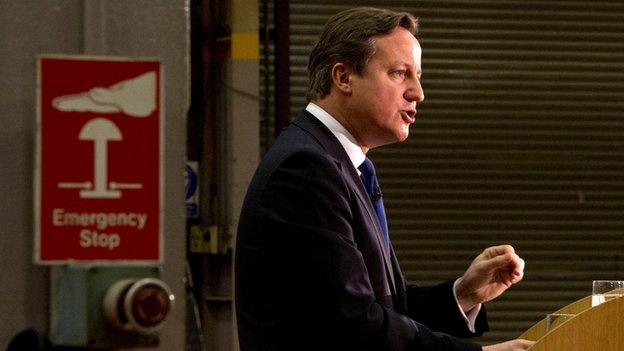What's the direction of Tory immigration policy?
- Published
- comments

Home Secretary Theresa May has delivered an uncompromising speech to her party conference pledging to crack down on immigration.
But it comes after some very challenging years for the Conservative Party in government which, like its predecessor, has struggled to find policies that have delivered exactly what the public were told to expect.

How did we get here?
The British immigration system is a hybrid: in some respects it is extremely tightly controlled. But in others it is almost entirely open.
In 1986 the late Baroness Thatcher, then prime minister, signed the Single European Act which created the European single market.
In 1992, her successor John Major agreed the Maastricht Treaty with other member states, allowing EU citizens to live and work elsewhere according to the single market principle.
Finally, when the EU began expanding eastwards, the then-Labour government did not impose transitional controls on workers from the former communist states, leading to the massive influx of eastern European workers.
People from other parts of the world find it far more difficult to arrive. They must apply for work visas and entry is dependent on their qualifications and, theoretically, whether there is a demand for their skills.
Students are treated differently. Universities can bring in foreign students and they can then apply to stay at the end of their courses.
What impact does immigration have on jobs and public services in the UK? Norman Smith reports

How has the Conservative policy developed in recent years?
In the run-up to the 2010 general election, the party lambasted Labour for a litany of immigration failures. It said the system was failing after net migration reached a record 320,000 in 2005. Net migration is the balance between the number of immigrants arriving minus the number of people leaving - and the Conservatives said they would get it down to "tens of thousands".
When it came to power, the coalition government placed an annual limit on the number of immigrants allowed into the UK from outside the European Union but it could not do anything about EU workers. It also raised the bar for family settlement by creating a minimum income threshold for anyone who wanted to bring their spouse to the country.
In its last bill before the 2015 general election, the government created measures which it said would make illegal immigration harder.

Did the government hit the net migration target?
No. Net migration began dipping in the early part of the last parliament but when the crisis in the eurozone deepened and, at the same time, the British economy began to expand, workers started arriving here in greater numbers.
In August this year, official statistics showed that a new record for net migration had been hit - 330,000 people in the year to March. The Conservatives stand by their pledge to get it down to tens of thousands.


So what do they propose to do about it?
Ministers keep talking about reforms to the single market itself. They want to prevent newly arriving workers from poorer EU countries claiming income-related benefits. They predict this will make the UK less attractive.
But some in the party argue that the only answer is to restrict EU free movement itself - something that other governments, up until now, have opposed.
The evidence for whether migrants choose their destination because of the benefits on offer is really limited. We simply don't know in any great detail whether this is a real factor in their decisions.

Is immigration good or bad for the UK ?
There's no single simple answer because you can pick and choose which factors you want to include in your calculation.
The NHS would collapse if it suddenly lost the third of its workforce that is born abroad. Those workers keep costs down because many are cheap and, in the cases of medical professionals like doctors and nurses, another country coughs up to train them.
But do these workers create pressures elsewhere, such as costs of extra housing or education of their children? These are the factors that have to be balanced.
In her conference speech, Mrs May said evidence from the OECD and the House of Lords Economic Affairs Committee puts the net economic effect of high migration as close to zero.
The Lords report she cites goes on to say that while overall fiscal impact of immigration is small, "this masks significant variations across different immigrant groups".
This table shows how widely different the estimates can be. One of the estimates comes from the government and another from a leading academic in the field. The other two come from the Institute of Public Policy Research, a left-leaning and broadly pro-migration think tank, and campaign group Migrationwatch UK:
Theresa May says there's "no case, in the national interest, for immigration of the scale we have experienced over the last decade" - but in 2013, the Office for Budget Responsibility arguably found one, external.
It estimated that high immigration would ease the burden of national debt over 50 years, suggesting it could rocket if net migration was cut to zero.

These projections were based on the fact that immigrants tend to be young and healthy. But those young workers would eventually age - begging the question: who would pay for them?
The economic effect can also vary by region. London is booming and many business leaders say that immigration is playing a key part in that growth. But in some poorer parts of the country, there is anecdotal evidence that cheaper workers from Europe not only undercut local people for the lowest-paid jobs, they also suppress wages.
- Published6 October 2015

- Published21 May 2015

- Published21 May 2015

- Published26 February 2015
